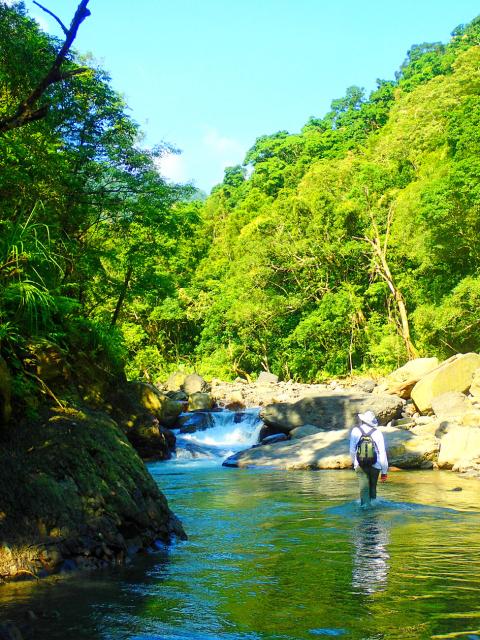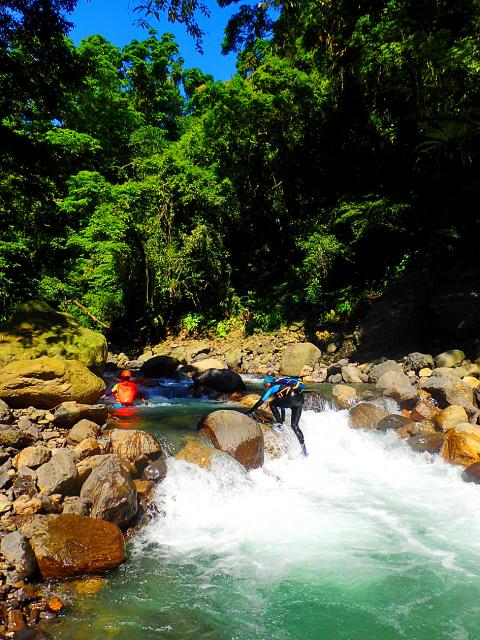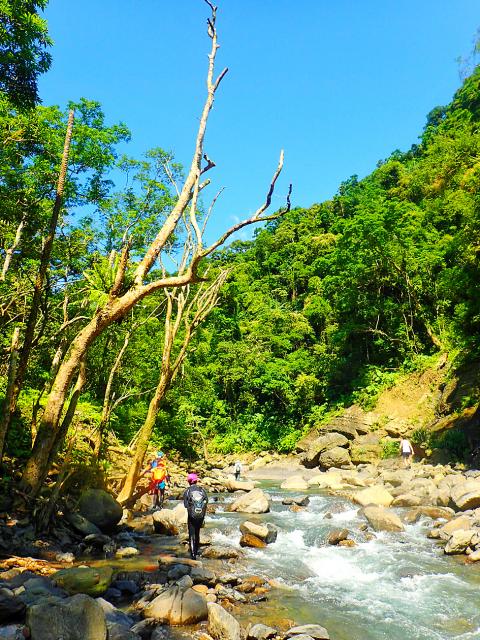Taipei’s stiflingly hot summers aren’t generally considered one of the great bonuses of living here, but for active types they provide a perfect excuse to get out into the wilds surrounding the capital and cool off in the many rivers and mountain streams nearby. And those who aren’t content to just go for a paddle are also in luck. Taiwan is arguably one of the world’s premier destinations for river tracing (better known in the West as canyoning), which isn’t surprising, since many fantastic river tracing streams can already be found within easy reach of the city by public transport
There are literally hundreds of streams suitable for a river-tracing trip in Taiwan, but the nation’s incredibly mountainous terrain and the remoteness of much of its interior means that many river tracing trips are either multiday camping expeditions, or have serious obstacles (such as waterfalls) that makes them strictly for the experienced and well equipped.
RIVER TRACING NATION

Photo: Richard Saunders
Indeed, Malishan Canyon (馬里桑溪) in Pingtung County was the setting last year for the world’s longest canyoning expedition to date, an epic eight-day descent by an international group of eight professional canyoneers. Footage from their amazing achievement has even been made into a documentary which can be viewed online.
The majority of river traces in Taiwan’s mountains require at the very least a little experience. However, several beautiful river traces within easy reach of Taipei city are suitable for beginners. Unfortunately for budding tracers (but fortunately for retaining the fragile environmental balance), all streams within Yangmingshan National Park (including several excellent easier river traces) have now been declared off-limits to river tracers. However, several other classic easy river traces close to Taipei remain open, and there’s simply no better way for active sorts to spend a boiling hot summer day.
The best-known river tracing spot close to the metropolis is probably the stunning Jiajiuliao Stream (加九寮溪), close to the hot spring resort of Wulai (烏來) and just a short bus ride south of Taipei city.

Photo: Richard Saunders
Catastrophic floods triggered by Typhoon Soudelor on Aug. 9th, 2015 caused immense damage to the Wulai area, and triggered many landslides on the steep sides of the gorge through which the stream flows, covering its many beautiful rock pools and lovely small waterfalls and cascades in a thick layer of silt and stones. In that wild couple of days, the once enchanting gorge became a scene of desolation.
Less than two years later, however, nature has begun to soften some of the harsher scars, and other (less damaging) typhoon floods have charged through and swept away some of the rubble. Tracers who knew and loved the original Jiajiuliao Stream will be amazed at how it’s changed, but although very different, and not as quite as enchantingly beautiful as it was pre-2015, the new Jiajiuliao is unlikely to disappoint the first-timer.
It’s about a 40-minute walk from the bus stop on the Wulai road to the start of the river trace. Simply step into the river, get accustomed to the chill water and start walking upstream. So much shingle and rock have been deposited on each bank by Soudelor that even after heavy rain it’s easy to avoid the deep pools and small cascades on the way.

Photo: Richard Saunders
After about two hours (less if you don’t stop for a paddle and splash, but where’s the fun in that?) the river widens into a deep and large natural swimming hole, fed by a curious narrow groove cut into the rock through which the river, constricted into a narrow channel, rages. This superb natural swimming pool has been a popular favorite with both locals and foreign outdoors lovers for decades, so visit on a weekday, or in the morning if you come on a weekend.
Most river tracers following the Jiajiuliao Stream find this deep, refreshing pool so paradisiacal that they can’t tear themselves away (fragments of trail from here climb to a larger path that leads back to the trailhead in about 20 minutes when they’re finished). Explorers who press on upstream will be rewarded by some of the finest river tracing terrain on the whole river, including several further fine pools, and an impressive waterfall which at first glimpse appears to a major barrier to further progress. Look carefully, though, and a trail on the right leads safely to the top, the beautiful, relatively unexplored upper reaches of the stream, and a few further surprises.
SAFETY TIPS
A simple, non-technical river trace such as the lower reaches of the Jiajiuliao Stream requires no special ability or skill to enjoy safely, but there are a few important points to note before taking the plunge. Don’t even consider trying a river trace unless you are a reasonably confident swimmer. In Taiwan, most beginners join an organized tour, where everything from footwear and wet suit to life vest, ropes and harness are provided.
In reality, the only essentials for an entry-level river trace like this are confidence, common sense and a pair of river-tracing footwear. These neoprene bootees with felt-covered soles are indispensable, as they help prevent slipping on algae-covered rocks. Hiking shoes or sandals should be avoided at all costs. Be sure also to bring a waterproof bag (for clothes, camera and other valuables) and preferably a helmet to protect the head in the event of a slip. All of these, plus knee and elbow pads (useful) and even wet suits (not really necessary for shorter river traces in summer), can be bought in any outdoor or hiking shop in Taipei for a reasonable price.
Choose a dry, settled day for river tracing, and don’t attempt it for a couple of days after heavy rain. During summer, afternoon thunderstorms can cause dangerous flash floods, so get an early start, keep an eye on the weather situation, be aware of any escape routes on the way and aim to be out of the water by early afternoon.
Richard Saunders is a classical pianist and writer who has lived in Taiwan since 1993. He’s the founder of a local hiking group, Taipei Hikers, and is the author of six books about Taiwan, including Taiwan 101 and Taipei Escapes. Visit his Web site at www.taiwanoffthebeatentrack.com.

June 2 to June 8 Taiwan’s woodcutters believe that if they see even one speck of red in their cooked rice, no matter how small, an accident is going to happen. Peng Chin-tian (彭錦田) swears that this has proven to be true at every stop during his decades-long career in the logging industry. Along with mining, timber harvesting was once considered the most dangerous profession in Taiwan. Not only were mishaps common during all stages of processing, it was difficult to transport the injured to get medical treatment. Many died during the arduous journey. Peng recounts some of his accidents in

“Why does Taiwan identity decline?”a group of researchers lead by University of Nevada political scientist Austin Wang (王宏恩) asked in a recent paper. After all, it is not difficult to explain the rise in Taiwanese identity after the early 1990s. But no model predicted its decline during the 2016-2018 period, they say. After testing various alternative explanations, Wang et al argue that the fall-off in Taiwanese identity during that period is related to voter hedging based on the performance of the Democratic Progressive Party (DPP). Since the DPP is perceived as the guardian of Taiwan identity, when it performs well,

The Taiwan People’s Party (TPP) on May 18 held a rally in Taichung to mark the anniversary of President William Lai’s (賴清德) inauguration on May 20. The title of the rally could be loosely translated to “May 18 recall fraudulent goods” (518退貨ㄌㄨㄚˋ!). Unlike in English, where the terms are the same, “recall” (退貨) in this context refers to product recalls due to damaged, defective or fraudulent merchandise, not the political recalls (罷免) currently dominating the headlines. I attended the rally to determine if the impression was correct that the TPP under party Chairman Huang Kuo-Chang (黃國昌) had little of a

A short walk beneath the dense Amazon canopy, the forest abruptly opens up. Fallen logs are rotting, the trees grow sparser and the temperature rises in places sunlight hits the ground. This is what 24 years of severe drought looks like in the world’s largest rainforest. But this patch of degraded forest, about the size of a soccer field, is a scientific experiment. Launched in 2000 by Brazilian and British scientists, Esecaflor — short for “Forest Drought Study Project” in Portuguese — set out to simulate a future in which the changing climate could deplete the Amazon of rainfall. It is